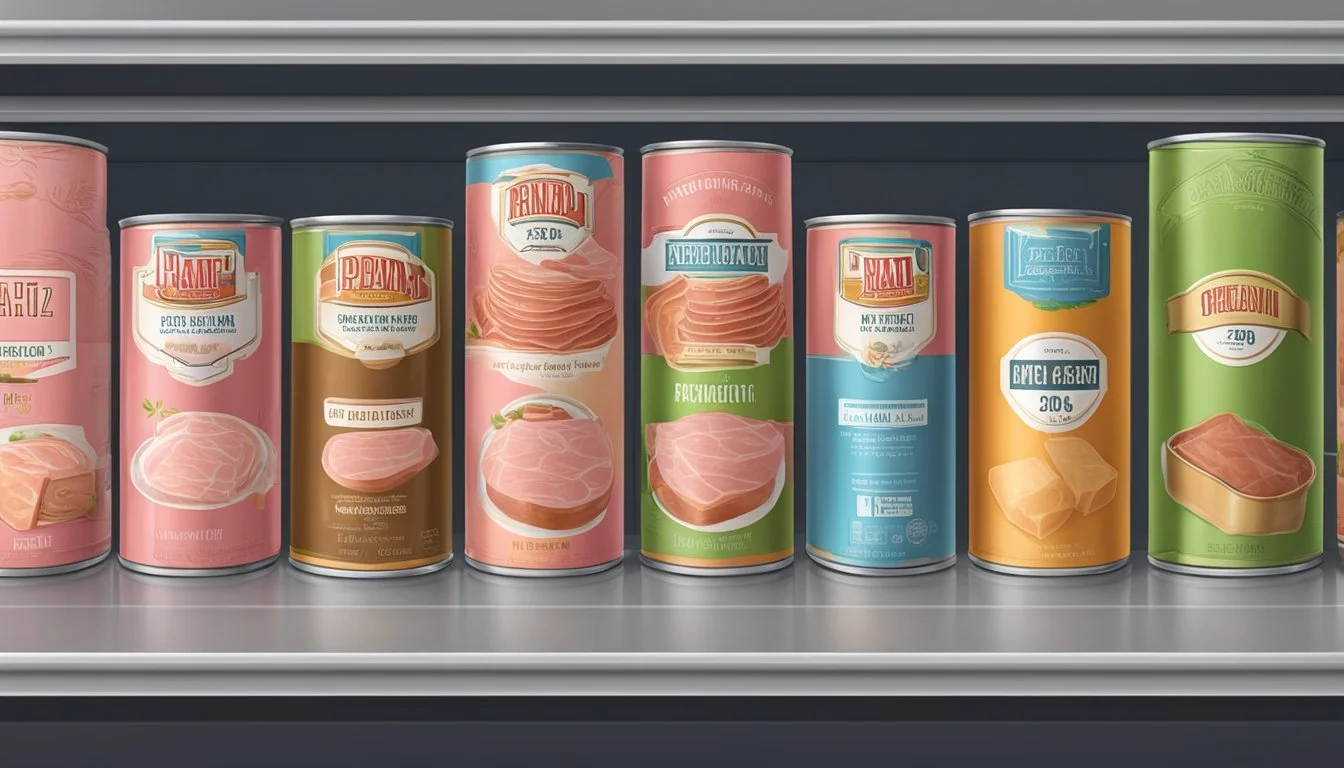Does Canned Ham Go Bad?
Shelf Life, Storage, and Safety Tips
Canned ham is a popular choice for many due to its convenience and long shelf life. Unopened shelf-stable canned ham can last for years if stored properly, but it's crucial to be able to recognize the signs that it has gone bad. Consumers should be aware of indicators such as bulging cans, off odors, or discoloration, which signify spoilage.
Although some recommend freezing canned ham to extend its shelf life, this can affect its texture and flavor. Storing canned ham in cool, dry places and paying attention to the "best if used by" dates can ensure that the product remains at its best quality for as long as possible.
Understanding the longevity of canned ham is essential for food safety and meal planning. While it offers a great way to keep ham on hand, being vigilant about its condition helps avoid the risks associated with consuming spoiled food.
Understanding Canned Ham
Canned ham is a staple in many households due to its long shelf life and versatility. This section explores what exactly canned ham is, how the canning process ensures its longevity, and the different types available.
Defining Canned Ham
Canned ham is a type of processed meat that has been cured and sealed in a can. It is pre-cooked and ready to eat, making it a convenient option for many meals. The curing process typically involves adding salt, nitrates, and sometimes sugars, which help preserve the meat and enhance its flavor. Shelf-stable canned hams do not require refrigeration until opened, adding to their practicality.
The Canning Process and Shelf Stability
The canning process involves placing the ham in a sterile can and then heating it to a high temperature. This heating kills bacteria and other pathogens, ensuring the meat is safe to eat. The airtight seal of the can prevents new contaminants from entering, which contributes to the long shelf life. Shelf-stable canned hams can last up to two years, although they may lose quality after three years. Any cans showing signs of bulging, rusting, or leaks should be discarded.
Types of Canned Ham
There are various types of canned ham available on the market. Shelf-stable canned hams can be stored at room temperature. Refrigerated canned hams need to be kept cold and typically have a shorter shelf life. There are also different portion sizes, from small single-serving cans to larger sizes meant for family meals. The choice of type depends on consumer needs and storage capabilities.
Shelf Life and Expiration
Understanding the shelf life and expiration of canned ham is crucial to ensure safe consumption. This section will cover how to determine the shelf life, the meaning of expiration dates and food safety, as well as the quality of canned ham over time.
Determining Shelf Life
Unopened shelf-stable canned ham typically lasts for a long period. When stored properly in a cool, dry place between 40°F to 60°F, it can maintain its quality for up to 2 years. Some sources indicate it can be safe and edible for up to 5 years if conditions are ideal. Proper storage conditions are essential in maximizing the shelf life and preventing spoilage.
Opened canned ham has a much shorter shelf life. Once opened, it should be refrigerated and consumed within 3 to 4 days to ensure safety. It is important to transfer the ham into an airtight container to preserve its freshness and prevent contamination.
Expiration Date and Food Safety
Expiration dates are marked on canned ham to guide consumers on safe consumption. Terms like "best by," "best before," and "best if used by" indicate the period during which the product is at its peak quality. These dates are not safety dates but quality indicators.
Canned ham may still be safe to eat past these dates, but its quality may degrade. If the can is damaged, rusted, or swollen, it should be discarded regardless of the expiration date. Always inspect the can and the product inside for unusual smells, colors, or textures before consuming.
Quality Over Time
Over time, the quality of unopened canned ham can decline, though it remains safe to eat. The texture and flavor may not be as appealing after the peak quality period indicated by the "best by" date. Maintaining proper storage conditions is key to preserving its quality for as long as possible.
Unopened canned ham stored beyond 2 years may become less tasty and slightly drier. For the best experience, consume the ham within the recommended period. Opened cans should be handled with care, ensuring they are tightly sealed and refrigerated to retain the quality as much as possible.
Proper Storage Practices
Proper storage ensures the longevity and safety of canned ham. It is essential to follow guidelines for storing both unopened and opened canned ham, whether in the pantry, refrigerator, or freezer.
Storing Unopened Canned Ham
Unopened canned ham should be kept in a cool, dry place. A well-ventilated pantry or a kitchen cabinet away from heat sources like stoves and direct sunlight is ideal. Proper storage conditions can extend the shelf life of unopened canned ham to two to five years.
Maintaining a constant, moderate temperature is crucial. High humidity and fluctuating temperatures can compromise the integrity of the can, leading to potential spoilage.
Storing Opened Canned Ham
Once a can of ham is opened, it should be transferred to an airtight container and placed in the refrigerator. Temperature control is vital, keeping it at or below 40°F (4°C) to prevent bacterial growth.
Make sure to use the opened ham within 3-5 days to enjoy optimal freshness. If longer storage is necessary, freezing is recommended.
Freezing and Refrigeration Tips
Freezing ham is a suitable method for extending its shelf life. Before freezing, ham should be wrapped tightly in plastic wrap or placed in a vacuum seal bag to prevent freezer burn and maintain quality.
Ham can be stored in the freezer at 0°F (-18°C) or lower for 1-2 months. Always label and date the packaging to keep track of storage time.
In the refrigerator, refrigerated canned ham can remain unopened for 6 to 9 months, provided it is stored properly. Regularly check the packaging for any signs of damage or spoilage.
Health and Nutrition
When considering the health aspects of canned ham, it's crucial to look at both its nutritional benefits and the risks related to consuming it when spoiled.
Nutritional Benefits of Ham
Canned ham offers various nutritional advantages. It is a great source of protein, making it beneficial for those needing a protein boost. A typical serving contains around 4 grams of fat and 100 calories, providing a reasonably low-calorie protein source without added sugars or carbs.
Ham also contains essential vitamins and minerals like vitamin B6 and zinc, which support metabolism and immune function.
However, canned ham is high in sodium, often used as a preservative. While salt helps extend shelf life, excessive sodium intake can lead to health issues such as hypertension.
Risks of Consuming Spoiled Canned Ham
Eating spoiled canned ham poses significant health risks. Over time, ham can deteriorate, making it unsafe for consumption. Signs of spoilage include an off smell, slimy texture, and changes in color.
Spoiled ham can harbor harmful bacteria like Listeria and Staphylococcus, leading to foodborne illnesses. Symptoms may include nausea, vomiting, diarrhea, and fever.
To avoid these risks, always check the "best if used by" dates and store it properly. Refrigerated canned ham stays safe for 6 to 9 months when unopened, while frozen ham lasts longer but may alter in texture.
Proper storage and regular inspection can help prevent foodborne illnesses, ensuring that the ham is safe and nutritious to consume.
Serving and Usage
Canned ham offers versatile options for meals and snacks. Understanding the best ways to serve it and how to handle leftovers ensures optimal taste and safety.
Ways to Serve Canned Ham
Canned ham can be served in various ways, making it a handy addition to many dishes. Sliced ham can easily be added to sandwiches for a quick and satisfying meal. Whole hams can be glazed and baked, providing a convenient alternative to fresh ham.
For a flavorful twist, consider glazing the ham with honey, brown sugar, or a mix of mustard and herbs before cooking. This adds a rich, savory element which enhances the taste.
Canned ham is also suitable for chopping and adding to soups, salads, or casseroles. Its texture and flavor integrate well with other ingredients. This makes it a versatile protein source for a variety of recipes.
Leftovers and Reheating
Properly storing leftovers is crucial to maintaining the quality and safety of canned ham. Leftovers should be stored in airtight containers and refrigerated, where they can safely last for 3 to 5 days.
Reheating should be done evenly to avoid cold spots. It can be reheated in a skillet, microwave, or oven. When using a microwave, cover the ham with a damp paper towel to retain moisture. If reheating in an oven, wrap the ham in aluminum foil to prevent it from drying out.
It is essential to discard any ham that shows signs of spoilage, such as a sour odor or discoloration. Proper attention to storage and reheating methods ensures that canned ham remains a valuable and convenient component of meals.
Label Interpretation and Product Selection
Understanding how to interpret labels and selecting the right products are crucial steps in ensuring the freshness and quality of canned ham. These aspects help in making informed choices and maximizing shelf life.
Reading Labels for Freshness and Quality Indicators
Interpreting the various labels on canned ham products can aid in ensuring you select items that are at their best quality. Expiration dates, best by, and best before labels are critical.
Expiration dates indicate the last date the product should be consumed for safety reasons. Best by and best before dates suggest the period during which the product is expected to be at peak quality, offering the best flavor and texture.
Check for "sell by" dates, which guide retailers but can also indicate the product's timeline for best use at home. Also, ensure the can is undamaged and stored properly as dents or rust can compromise the ham's safety and shelf life.
Selecting the Right Canned Ham
Choosing the right canned ham involves considering several factors to ensure you get the highest quality product. Look for shelf-stable hams that do not require refrigeration until opened, making them ideal for long-term storage.
Opt for brands known for their high-quality standards, such as Hormel, which can impact the texture and flavor of the product. When shopping, consider the packaging – cans that are intact and free of dents are preferable.
Canned ham stored in a cool, dry environment can last between 2 to 5 years, but always check the labels for specific information related to freshness and quality. Being aware of these details will help in selecting products that meet your needs and maintain peak quality for as long as possible.






